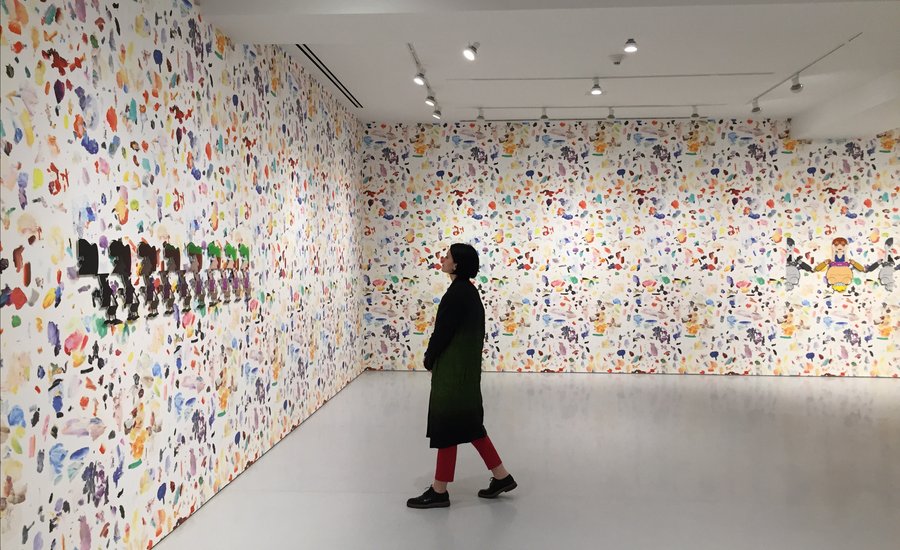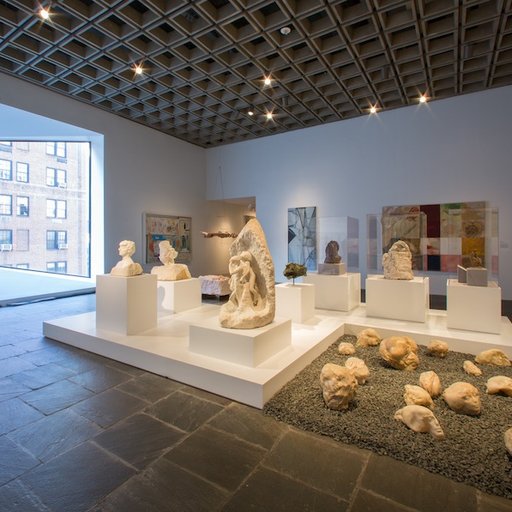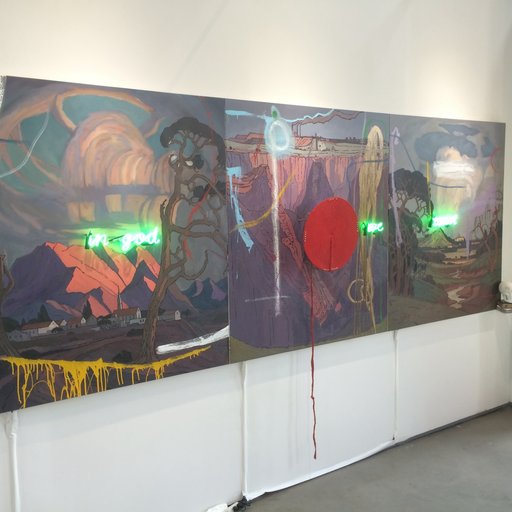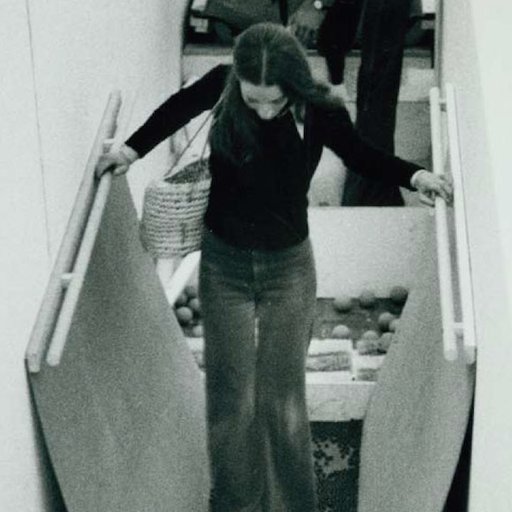Stretched out alongside the east flank of Central Park like a satisfied cat lying in the sun, the Upper East Side—longtime home to tycoons and celebrities—is still the most luxe neighborhood in New York City, where foreign billionaires plant their money in $100 million manses and ridiculous trend stories (the Glam SAHMs?) spring from the moneyed elite. But such enclaves often harbor secrets, and this one has a big one: the three dozen blocks between 60th Street and 96th Street have become the best place to see art in New York.
Now, the best place to see new, cutting-edge, boundary-expanding work? That’s still the Lower East Side. But the Upper East Side is your destination if you want to see art in a context that is both up-to-date but not overly besotted with the contemporary, that is delicate and slow, and where you can encounter wise artworks from across both recent and deeper history, like some gauzy cinematic vision of heaven where Plato and Steve Jobs are having a ping-pong match while Kierkegaard takes bets. And, indeed, on a good, bright, clear day, a walk on the Upper East Side’s gallery circuit offers up a present-day dose of Matthew Arnold’s “sweetness and light.”
Don’t believe me? Here are 16 reasons to give the neighborhood a second look.
1. IT’S THE CITY’S CAPITAL OF CONNOISSEURSHIP
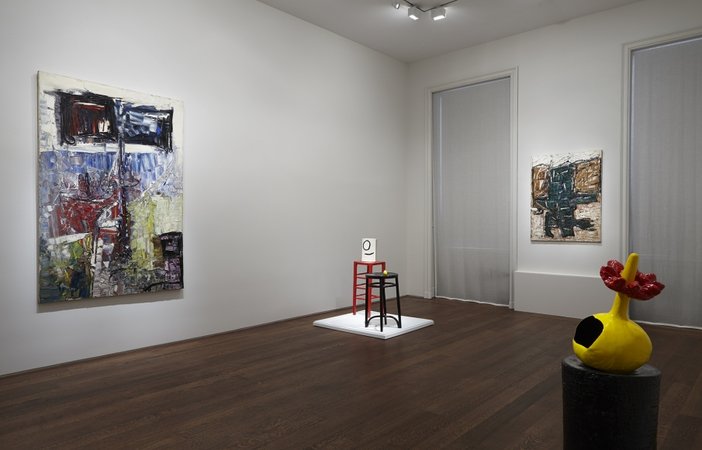 A show of Miro's sculptures and Riopelle paintings at Acquavella
A show of Miro's sculptures and Riopelle paintings at Acquavella
The Metropolitan Museum of Art, Frick, Neue Galerie, Guggenheim, and the Jewish Museum are the glittering landmarks of New York’s fabled Museum Mile, attracting tourists from around the world and serving locals with the salubrious fruits of art history. But while the neighborhood’s gallery scene was once synonymous with Old Masters and Impressionism (with a smattering of edgy, Pop-heavy fare in the postwar decades thanks to Leo Castelli and others), when it comes to the area’s new art landscape, the just-opened Met Breuer captures the tenor best. That’s because it intermingles historic pieces with newer art in pursuit of deeper, trans-temporal contexts—and that’s the kind of enrichment that await visitors to the Upper East Side’s galleries.
Dip into Broadway 1602’s inaugural exhibition on 5 East 63rd Street and find remarkable works by too-long-overlooked women artists from the 1970s and ‘80s like Evelyne Axell, Rosemarie Castoro, Babette Mangolte alongside site-specific pieces by Paul P. and Lydia Okumura. At Dominique Levy, on 73rd and Madison, you could recently encounter a suite of potent never-before-seen drawings that fresh Golden Lion-winner Adrian Piper made when she was 19 (on hold to MoMA for €450,000), together with other knockout works on paper by Ed Ruscha, Jasper Johns, Vija Celmins, Cy Twombly, Agnes Martin, and dozens more. Expertly curated by Kate Ganz, editor of Jasper Johns’s drawings catalogue raisonné, the show was filled with lustworthy objects.
The name of the game up here, in other words, is context—a feeling of walking through an art-historical continuum, probably helped in some mystical way by pulsations picked up from the nearby Met. Even the most cutting-edge dealers feel it’s the right place to show older work, so Petzel Gallery can put on a bracing survey of Charline von Heyl’s Düsseldorf paintings from the ‘90s, Hauser & Wirth can let rip with its extraordinary estate holdings, and places like Aquavella, Skarsdedt, and Werner can dazzle with object lessons in the mastery of such postwar artists as Lucien Freud, Marcel Broodthaers, and Willem de Kooning. This is museum-quality stuff, pure and simple.
2. THE NEIGHBORHOOD IS RICH WITH NEW BLOOD
 Lucy McKenzie at Galerie Buchholz
Lucy McKenzie at Galerie Buchholz
Recently, in addition to the opening of the Met Breuer and Broadway 1602’s new space, the major international galleries Petzel, Blum & Poe, and Galerie Buchholz have opened here; the nonprofit Artist’s Institute has relocated from Chinatown to 65th Street; and both Franklin Parrasch and Van Doren Waxter have moved up from the 50s, to 64th Street and 73rd Street respectively. Also, earlier this year it was announced that TEFAF, Maastricht’s legendary historical-art fair, will be launching two editions at the Park Avenue Armory this fall and next spring—joining the ADAA’s March Art Show and supplanting Artvest’s Spring Masters fair, which will hold its last edition there this May.
3. ALL THE GALLERIES CAN BE SEEN IN A VERY PLEASANT AFTERNOON
 Sant Ambroeus on Madison
Sant Ambroeus on Madison
Start with Sandra Gering or Broadway 1602 at the southernmost tip and meander your way uptown (even all the way to Salon 94 on 94th Street), popping into galleries as you go. Maybe poke your head into the Prada, Valentino, Gucci, Celine, or Marni flagship stores along Madison for a few ganders at the latest fashions—they are among the most art-forward designers, after all.
Grab a coffee at Hôtel Plaza Athénée, or a perfectly proportioned brie-and-prosciutto-cotto sandwich (to go) at Bel Ami Café for some fortification, then maybe a mid-afternoon martini at Bemelman’s Bar at the Carlyle, or a first-rate gelato at Sant Ambroeus. (These delights may be pricey, but not break-the-bank so, and are among the most enjoyable examples in the city.)
While galleries may be near closing time when you’re done, you won’t be overwhelmed with visual overload—or at least nothing that a quick dip into a dusky Central Park couldn’t cure. Compare that to Chelsea or the Lower East Side, which require working up a tremendous sweat for even a partial tour.
4. TWO WORDS: CENTRAL PARK

Arguably the greatest public artwork in New York, Central Park was sculpted in 1857 by Frederick Law Olmsted and Calvert Vaux as an urban idyll that injected a bit of American freewheelingness to the classicizing parks of Europe, and even a quick sidelong glance at its waving greenery while walking up Madison provides a tonic effect. To paraphrase Werner Herzog’s comparison of Marlon Brando and Klaus Kinsky, the High Line is kindergarten next to Central Park.
5. THE UPPER EAST SIDE IS OUR EUROPE
 Galerie Buchholz again
Galerie Buchholz again
With its magnificent prewar architecture, verdigris-capped rooftops, open boulevards, and slower pace, the Upper East Side provides an escape from the tumult of downtown, and its galleries—often located in grand brownstones that, if you squint, recall the palazzi of Venice or maisons particulières of Paris—are islands of elegant calm. It’s no wonder that Europeans like Petzel, Perrotin, Werner, Buchholz, Dominique Levy, Skarstedt, and Hauser & Wirth are drawn to the neighborhood. It’s their spiritual home across the pond.
6. YOU’RE WELCOMED INTO SOMEONE’S HOME
 Tilton Gallery
Tilton Gallery
While in the past the galleries up here were often forbidding showrooms to the wealthy, the widespread democratization of the art experience has reached this precinct too, so now expect to be greeted with a smile and a laminated show guide or exhibition statement when entering the door. The setting then works its charm. Unlike the white cubes so prevalent elsewhere, these galleries are refined domestic spaces, with a fireplace here, a creaky staircase there, and warmly varnished wooden floors.
They can even be charmingly tatterdemalion, as with the worn carpet on the stairs leading to Michael Werner. Everything feels homey, and the art on the walls becomes friendlier, in a way, as a result. These are artworks the way people used to live with them—at least before architects like Max Gordon and Annabelle Selldorf convinced collectors that they had to live in white cubes too.
Also, hear that sound? That’s quiet. Most often you’ll be the only visitor in the gallery, so take your time and enjoy.
7. THE VILLAINS ARE (MOSTLY) GONE
 The closing of Salander O'Reilly
The closing of Salander O'Reilly
Bastions of the old guard who sold Caravaggios and Rubens battle scenes from their marmoreal palaces while secretly dealing in nefariousness under the table, the warhorse galleries Salander O’Reilly and Wildenstein were both laid low by shocking trials that exposed the former of running an elaborate Ponzi scheme and the latter of trafficking in Nazi loot. Knoedler, then, closed its high Modern temple after being unmasked as an emporium of fakes.
Now the shadowiest dealings that remain are concocted by the Nahmad clan, who control a $2 billion store of masterpieces and whose scion, Helly Nahmad, was jailed for running an international gambling ring with alleged ties to the Russian mob. (You'll find his name on the marquee of their flagship Madison Avenue gallery, which recently partnered with Phoenix Ancient Art, an Upper East Side antiquities gallery that has previously been accused of peddling looted artifacts.)
8. DAVIS AND LANGDALE EXISTS
 Cecily Langdale, at right, with gallery director Meredith Mueller
Cecily Langdale, at right, with gallery director Meredith Mueller
Speaking of Europe, you’ll find a little slice of Britain in the ivy-fronted home of Davis and Langdale, a veteran gallery hidden among the antique shops of 60th Street. (It’s next to Serendipity.) Founded in 1952 by Roy Davis, who had studied for three years under Albert Barnes himself at Philadelphia’s Barnes Foundation, this lesser-known operation is now run by Davis’s wife Cecily Langdale, a specialist in the artists of the Bloomsbury School and the Welsh painter Gwen John, the partner and model of Rodin.
As you might imagine, the gallery is a scholarly affair (Langdale wrote John’s catalogue raisonée), as historical as its 1870 building and as atmospherically musty as a John Bellairs library. At one point it was a high-flying affair, bringing the first show of Lucien Freud to the United States in 1978, but now the gallery has eased into a quieter rhythm, representing eight artists, including Vassar professor Harry Roseman and a jewelry artist named Bessie Jamieson who recreates ancient Roman and Byzantine ornaments.
Prices are reasonable, mostly between $1,000 and $2,000, and it’s now only open to the public on Saturday, available the rest of the week by appointment. But ring the buzzer anyway. “I keep telling people, ‘Don’t send anyone away!’” a gracious Langdale says.
9. DAVID HAMMONS'S SHOW WOULDN’T BE AS GOOD ANYWHERE ELSE
 The David Hammons opening
The David Hammons opening
Sure, people would show up nearly anywhere for a show by David Hammons, the rare-appearing art genius whose work just gets more urgent as time goes on. But there was something magical about his politically freighted survey of adjusted African totems, dribbled-basketball paintings, body prints, cat taxidermy, and beheaded hoodies (mordantly titled In the Hood) appearing at ex-Goldman Sachs banker Robert Mnuchin’s baronial townhouse on 78th Street. It felt like Hammons was getting away with something, and in spectacular fashion. The line out the door at the opening suggested that the city’s art community sensed it too.
10. THE GAGOSIAN BUILDING IS A TRIP

Come to 980 Madison for the dazzling shows at Gagosian, from John Richardson-orchestrated Picasso surveys to the new Instagram-demanding Urs Fischer extravaganza (replete with the smell of cooking bacon, furnished from a microwave on the gallery floor)—but stay for the meticulous exhibitions at Adam Lindemann’s Venus Over Manhattan, the brilliant photography-in-the-expanded-field shows at Higher Pictures, and the zen presentations at Yoshii Gallery. Pro tip: the bathrooms on the 4th and 5th floors are lovely amenities.
11. 19 EAST 66TH STREET IS ALSO A TRIP
 19 East 66th Street
19 East 66th Street
Where else can you enter a building and find a warmly welcoming gallery owned by the granddaughter of storied Picasso dealer Paul Rosenberg on the first floor (Marianne Rosenberg’s Rosenberg & Co), the contemporary-leading offshoot of a classic London Old Masters gallery on the second floor (Dickinson), and the Asian-inflected offshoot of a global contemporary powerhouse on the third and fourth floors (Blum & Poe)? This building is a layer cake that sounds so wrong, but tastes so right.
12. IT HAS ITS OWN EDGY, INDIE NONPROFIT
 Jenny Jaskey and A.E. Benenson
Jenny Jaskey and A.E. Benenson
Chelsea has the Kitchen, SoHo has Artists Space, the Lower East Side has Participant Inc. and the Abrons Art Center—now the Upper East Side has the Artist’s Institute. Partially supported by Hunter College, the space used to be located in Chinatown but moved up to a Hunter-owned building on 65th Street earlier this year, where it opened with a solo show of the art of Hilton Als. (Best known as the New Yorker’s theater critic and the author of White Girls, Als was also the second photo editor for the Village Voice and collaborated with filmmaker Darryl Turner in the ‘90s.)
The Artist’s Institute is run by director Jenny Jaskey with the help of A.E. Benenson as a series of six-month, multi-stage “seasons,” including talks and screenings, to showcase a particular talent, culminating in a printed magazine edited by that person. (Pierre Huyghe was the previous artist.) Now Jaskey is eager to take their new uptown home in the residential neighborhood as an opportunity to hold salons at supporters’ homes, echoing the tradition of the area’s bygone literary clubs. Which sounds very fun.
It should be added that there are also two other, smaller college galleries nearby, the Syracuse’s Palitz Gallery at the Joseph I. Lubin House on 11 East 61st Street—which is now featuring a selection by the gay Yoruba photographer Rotimi Fani-Kayode—and the Institute of Fine Arts’s lobby gallery, which last November presented a show of sculpture by Walead Beshty.
13. SARAH MEYOHAS HAS MADE A NICHE FOR EXPERIMENTAL ART
 The crowd at a Meyohas Gallery opening
The crowd at a Meyohas Gallery opening
On the 28th-floor of a Philip Johnson-designed building on 90th Street, the 25-year-old artist Sarah Meyohas has transformed her apartment—which boasts wraparound views down Third Avenue and across the East River—into a scrappy little gallery for group shows by emerging artists. On Friday night, the Iranian artist Shahrzad Changalvaee and Chilean filmmaker Constanza Alarcón Tennen (both Yale MFAs, like Meyohas) debuted a tightly conceived display of fictionalized counter-histories and poetic visual commentaries on the relationships between the autocratic histories of their countries.
Beer was served, paint-splattered young artists came and lounged around, watching the films, and a lady with a parrot on her shoulder (which seemed to be wearing a crocheted sweater of some kind around its birdy little neck) occasioned a frenzy of iPhone snaps. For a previous show by Brock Enright, an illustrious crowd including the Belgian art theorist Thierry de Duve attended.
A rising young artist, Meyohas recently got some media attention for her almost-sold-out show at 303 Gallery that included drawings made by manipulating the stock market—and then still more media attention when Charles Schwab closed her brokerage account after catching wind of her shenanigans. Her gallery may also lead to a new financialized product (a kind of curatorial service for collectors), so stay tuned.
14. THE GLADSTONE BUILDING IS POSSIBLE

In Chelsea, buying a decent gallery space will set you back about a cool $50 million. So what can you get for a comparably reasonable $10 million on the Upper East Side. An architectural landmark designed (and then inhabited) by Edward Durell Stone, the architect behind MoMA’s much-missed 1939 building. A four-story townhouse with a distinctive white concrete grid over its glass façade, the building was previously owned by Knoll CEO Andrew Cogan, who bought it for $4.95 million in 2004 and last year sold it for twice as much to gallerist Barbara Gladstone, who had it renovated by architect Jonathan Caplan.
Now presenting a gorgeously lyrical show of flickering lights and floating balloon fish by Philippe Parreno, the gallery is a romantic throwback to heyday of New York’s Modern architecture, as interpreted by the city’s own Boromini (to Philip Johnson’s Bernini). Overnight, it’s become an indispensable place to see contemporary art, and a shot of electricity into the program of one of New York’s most respected dealers. Ring the bell, say hi to the friendly gallery assistants, and enjoy a few minutes of irresistible uplift.
15. YOU COULD START YOUR OWN GALLERY IN A BUILDING LIKE THIS
 A vacant Upper East Side Gallery just waiting to be opened
A vacant Upper East Side Gallery just waiting to be opened
16. IT MAY NOT MAKE THE BEST BUSINESS SENSE
 Parreno's floating fish
Parreno's floating fish
A former deputy to Gavin Brown, Alex Zachary has an unusually good grasp of the new Upper East Side gallery dynamic. For one thing, he grew up on 77th Street. For another, he briefly ran his own gallery here, also on 77th Street, and then was tapped by Daniel Buchholz to open his Upper East Side outpost. Here’s his (condensed) perspective on where things are:
“My reasons for opening on the Upper East Side were semi-ironic. I signed the lease in 2009, in the aftermath of the collapse of the art market, as a half-juvenile gesture: I was a 26-year-old opening a gallery in a dilapidated townhouse on the Upper East Side. It’s completely different now. The folks who are opening are some of the best primary-market dealers, and their modus for coming to the Upper East Side is largely personal—they love New York and a lot of their artists are based in New York, so they wanted to spend more time here.
“The jury is still out on whether these new spaces on the Upper East Side actually contribute to the bottom line of any of these legacy galleries. I would be surprised if they were actually producing a profit at this point—but they obviously provide another occasion for the galleries to interact with their artists, and for their artists to produce another show of work in more of a project-space environment, and for the dealers to interface with their clients and the critical and curatorial apparatus.
“But the idea of that they’re tapping into new buyers here, I don’t think that’s a thing. Wealthy people of course still live on the Upper East Side, but the number of sales that are produced in person, first of all, has been diminishing for years—most take place on the phone or by email. And everyone by now is used to not only going downtown but flying halfway around the world to buy art, so the notion that a client would be more inclined to purchase an artwork if it was in their neighborhood than in Chelsea or Basel is probably not correct. I can’t think that any serious collector would be persuaded to buy something because it was closer to their house.
“So while the physical spaces are part of the great long tradition of art galleries in New York, whether they endure from a business standpoint is a separate question.”
In recent years, two Upper East Side galleries, Steven Harvey Fine Art Projects and Betty Cunningham, moved to the Lower East Side, and Marianne Boesky closed her 64th Street townhouse space in January. In other words, it's an art neighborhood that might not remain this vital forever—so enjoy it while it lasts.











